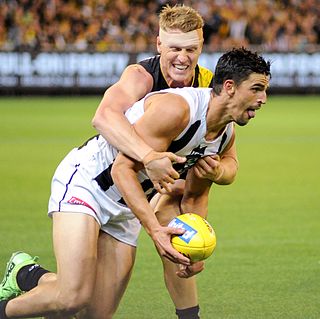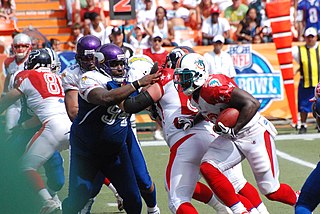
Canadian football, or simply football, is a sport in Canada in which two teams of 12 players each compete on a field 110 yards (101 m) long and 65 yards (59 m) wide, attempting to advance a pointed oval-shaped ball into the opposing team's end zone.

Most forms of football have a move known as a tackle. The primary purposes of tackling are to dispossess an opponent of the ball, to stop the player from gaining ground towards goal or to stop them from carrying out what they intend.

In gridiron football, a lineman is a player who specializes in play at the line of scrimmage. The linemen of the team currently in possession of the ball are the offensive line, while linemen on the opposing team are the defensive line. A number of NFL rules specifically address restrictions and requirements for the offensive line, whose job is to help protect the quarterback from getting sacked for a loss, or worse, fumbling. The defensive line is covered by the same rules that apply to all defensive players. Linemen are usually the largest players on the field in both height and weight, since their positions usually require less running and more strength than skill positions.

The tight end (TE) is an offensive position in American football, arena football, and Canadian football. It is a hybrid that combines the characteristics and roles of both an offensive lineman and a receiver. As part of the receiver corps, they play inside the flanks (tight), contrasted with the split end who plays outside the flanks (wide). Like offensive linemen, they are usually lined up on the offensive line and are large enough to be effective blockers. On the other hand, unlike offensive linemen, they are eligible receivers and potent weapons in a team's offensive schemes.
In American and Canadian football, a single-wing formation was a precursor to the modern spread or shotgun formation. The term usually connotes formations in which the snap is tossed rather than handed—formations with one wingback and a handed snap are commonly called "wing T" or "winged T".
This is a glossary of terms used in Canadian football. The Glossary of American football article also covers many terms that are also used in the Canadian version of the game.
- Legally positioned at the kick-off or the snap. On kick-offs, members of the kicking team must be behind the kick-off line; members of the receiving team must be at least 10 yards from the kick-off line. On scrimmages, at the snap the offence must be behind the line of scrimmage; the defence must be at least one yard beyond the line of scrimmage.
- A player of the kicking team who can legally recover the kick. The kicker and any teammates behind the ball at the time of the kick are onside. Thus on kick-offs all players of the kicking team are onside, but on other kicks usually only the kicker is. The holder on a place kick is not considered onside.
- A defensive position on scrimmages, also called free safety. Typical formations include a single safety, whose main duty is to cover wide receivers. See also defensive back.
- A two-point score. The defence scores a safety when the offence carries or passes the ball into its own goal area and then fails to run, pass, or kick the ball back into the field of play; when this term is used in this sense, it is also referred to as a safety touch.
Strategy is a major part of American football.

Gameplay in American football consists of a series of downs, individual plays of short duration, outside of which the ball is or is not in play. These can be plays from scrimmage – passes, runs, punts or field goal attempts – or free kicks such as kickoffs and fair catch kicks. Substitutions can be made between downs, which allows for a great deal of specialization as coaches choose the players best suited for each particular situation. During a play, each team should have no more than 11 players on the field, and each of them has specific tasks assigned for that specific play.

Orlando Lamar Pace is an American former football offensive tackle who played for 13 seasons in the National Football League (NFL), primarily with the St. Louis Rams. Pace played college football for the Ohio State Buckeyes, where he twice received unanimous All-American honors, and was selected by the Rams first overall in the 1997 NFL draft. He spent all but one season of his professional career in St. Louis, concluding his NFL tenure as a member of the Chicago Bears.

Glenn Scobey Warner, most commonly known as Pop Warner, was an American college football coach at various institutions who is responsible for several key aspects of the modern game. Included among his innovations are the single and double wing formations, the three point stance and the body blocking technique. Fellow pioneer coach Amos Alonzo Stagg called Warner "one of the excellent creators". He was inducted as a coach into the College Football Hall of Fame as part of its inaugural class in 1951. He also contributed to a junior football program which became known as Pop Warner Little Scholars, a popular youth American football organization.

In American football, blocking or interference involves legal movements in which one player uses his body to obstruct another player's path. The purpose of blocking is to prevent defensive players from tackling the ball carrier, or to protect a quarterback who is attempting to pass, hand off or run the ball. Offensive linemen and fullbacks tend to do the most blocking, although wide receivers are often asked to help block on running plays and halfbacks may be asked to help block on passing plays, while tight ends perform pass blocking and run blocking if they are not running routes to receive passes. Overall, blocking is a skill that virtually every football player may be required to do at some point, even defensive players in the event of a turnover.

In American football, the specific role that a player takes on the field is referred to as their "position". Under the modern rules of American football, both teams are allowed 11 players on the field at one time and have "unlimited free substitutions", meaning that they may change any number of players during any "dead ball" situation. This has resulted in the development of three task-specific "platoons" of players within any single team: the offense, the defense, and "special teams". Within these three separate "platoons", various positions exist depending on the jobs that the players are doing.
In American football, a play is a close-to-the-ground plan of action or strategy used to move the ball down the field. A play begins at either the snap from the center or at kickoff. Most commonly, plays occur at the snap during a down. These plays range from basic to very intricate. Football players keep a record of these plays in a playbook.
The offensive backfield is an ambiguous generic term of football, which includes: (1) a place, namely the area of an American football field behind the line of scrimmage; and (2) a group classification of certain players positioned there, i.e., members of offense who begin plays behind the line, typically including any backs on the field, such as the quarterback, halfbacks and fullback. There are rules specific to the manner of play in that area.
The following terms are used in American football, both conventional and indoor. Some of these terms are also in use in Canadian football; for a list of terms unique to that code, see Glossary of Canadian football.

A defensive tackle (DT) is a position in American football that typically lines up on the line of scrimmage, opposite one of the offensive guards; however, he may also line up opposite one of the offensive tackles. Defensive tackles are typically the largest and strongest of the defensive players. Depending on a team's defensive scheme, a defensive tackle may be called upon to fill several different roles. These may include merely holding the point of attack by refusing to be moved, or penetrating a certain gap between offensive linemen to break up a play in the opponent's backfield. If a defensive tackle reads a pass play, his primary responsibility is to pursue the quarterback, or simply knock the pass down at the line if it is within arm's reach. Other responsibilities of the defensive tackle may be to pursue the screen pass or drop into coverage in a zone blitz scheme. In a traditional 4–3 defense, there is no nose tackle. Instead there are a left and a right defensive tackle. Some teams, especially in the National Football League (NFL), have a nose tackle in this scheme, but most of them do not.

The 7–2–2 defense or seven-box defense, used seven "down linemen", or players on the line of scrimmage at the time of the snap, two linebackers, and two safeties. Amos Alonzo Stagg invented the seven-box defense in 1890 at Springfield College. At that time, most teams were using a nine-man line on defense, and there were only three downs and no forward passes. The 7–2–2 was the base defense used by Knute Rockne at Notre Dame, as well as Mike Donahue at Auburn. Into the late 1930s, the 7–2–2 was still commonly employed inside the defender's thirty-yard line. It was considered "very strong against a running attack, but rather weak defensively against passes." The 7–2–2 was also employed when the opponent was expected to punt.

The 7–1–2–1, or seven-diamond defense, used seven "down linemen", or players on the line of scrimmage at the time of the snap, one linebacker, two safeties relatively close to the line and one safety farther downfield. The formation was created by Minnesota Golden Gophers coach Henry L. Williams in 1903, reputedly to stop Michigan back Willie Heston. By some accounts in the mid-1930s, the 7–1–2–1 was considered "almost obsolete" due to its weakness against the forward pass, whereas the 7–2–2 defense was still considered viable. Yet Bill Arnsparger notes the use of the seven-diamond from the 1940s into the 1960s, as a defensive adjustment to the common wide tackle 6 defenses of the time. Further, the form of the 7 diamond as derived from a wide tackle 6, with a more compact line spacing than the 1930s era 7 man lines, shows a marked similarity to the 46 defense of Buddy Ryan.

Stance is the position an American football player adopts when a play begins. There are three common stances used by linemen: two-point, three-point, and four-point. The stance names reference the number of points where a player's body is touching the ground while down in the stance. Each technique has its own strengths and weaknesses; therefore, each one is used accordingly in different situations. Furthermore, stances are taught and used differently depending on the level of competition.













